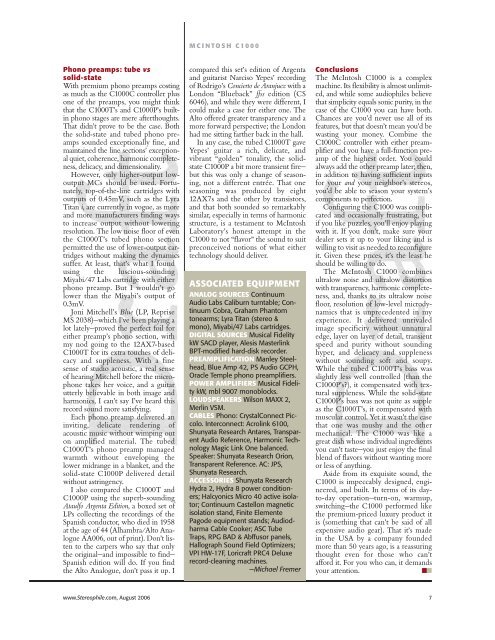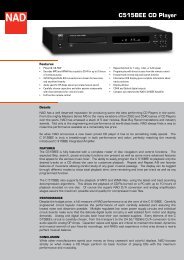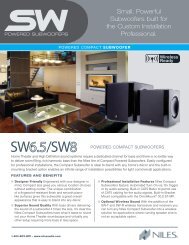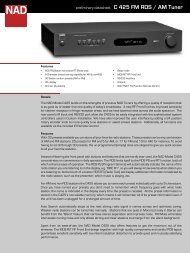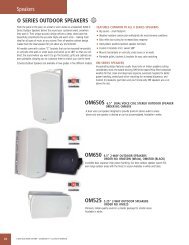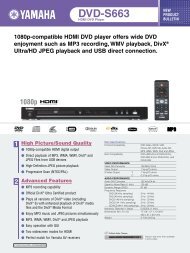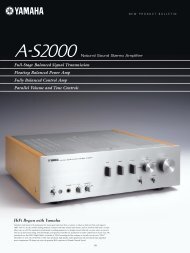McIntosh C1000 Stereophile Review - The Listening Post
McIntosh C1000 Stereophile Review - The Listening Post
McIntosh C1000 Stereophile Review - The Listening Post
Create successful ePaper yourself
Turn your PDF publications into a flip-book with our unique Google optimized e-Paper software.
MCINTOSH <strong>C1000</strong>Phono preamps: tube vssolid-stateWith premium phono preamps costingas much as the <strong>C1000</strong>C controller plusone of the preamps, you might thinkthat the <strong>C1000</strong>T’s and <strong>C1000</strong>P’s builtinphono stages are mere afterthoughts.That didn’t prove to be the case. Boththe solid-state and tubed phono preampssounded exceptionally fine, andmaintained the line sections’ exceptionalquiet, coherence, harmonic completeness,delicacy, and dimensionality.However, only higher-output lowoutputMCs should be used. Fortunately,top-of-the-line cartridges withoutputs of 0.45mV, such as the LyraTitan i, are currently in vogue, as moreand more manufacturers finding waysto increase output without loweringresolution. <strong>The</strong> low noise floor of eventhe <strong>C1000</strong>T’s tubed phono sectionpermitted the use of lower-output cartridgeswithout making the dynamicssuffer. At least, that’s what I foundusing the luscious-soundingMiyabi/47 Labs cartridge with eitherphono preamp. But I wouldn’t golower than the Miyabi’s output of0.3mV.Joni Mitchell’s Blue (LP, RepriseMS 2038)—which I’ve been playing alot lately—proved the perfect foil foreither preamp’s phono section, withmy nod going to the 12AX7-based<strong>C1000</strong>T for its extra touches of delicacyand suppleness. With a finesense of studio acoustic, a real senseof hearing Mitchell before the microphonetakes her voice, and a guitarutterly believable in both image andharmonics, I can’t say I’ve heard thisrecord sound more satisfying.Each phono preamp delivered aninviting, delicate rendering ofacoustic music without wimping outon amplified material. <strong>The</strong> tubed<strong>C1000</strong>T’s phono preamp managedwarmth without enveloping thelower midrange in a blanket, and thesolid-state <strong>C1000</strong>P delivered detailwithout astringency.I also compared the <strong>C1000</strong>T and<strong>C1000</strong>P using the superb-soundingAtaulfo Argenta Edition, a boxed set ofLPs collecting the recordings of theSpanish conductor, who died in 1958at the age of 44 (Alhambra/Alto AnalogueAA006, out of print). Don’t listento the carpers who say that onlythe original—and impossible to find—Spanish edition will do. If you findthe Alto Analogue, don’t pass it up. Icompared this set’s edition of Argentaand guitarist Narciso Yepes’ recordingof Rodrigo’s Concierto de Aranjuez with aLondon “Blueback” ffss edition (CS6046), and while they were different, Icould make a case for either one. <strong>The</strong>Alto offered greater transparency and amore forward perspective; the Londonhad me sitting farther back in the hall.In any case, the tubed <strong>C1000</strong>T gaveYepes’ guitar a rich, delicate, andvibrant “golden” tonality, the solidstate<strong>C1000</strong>P a bit more transient fire—but this was only a change of seasoning,not a different entrée. That oneseasoning was produced by eight12AX7s and the other by transistors,and that both sounded so remarkablysimilar, especially in terms of harmonicstructure, is a testament to <strong>McIntosh</strong>Laboratory’s honest attempt in the<strong>C1000</strong> to not “flavor” the sound to suitpreconceived notions of what eithertechnology should deliver.ASSOCIATED EQUIPMENTANALOG SOURCES ContinuumAudio Labs Caliburn turntable; ContinuumCobra, Graham Phantomtonearms; Lyra Titan (stereo &mono), Miyabi/47 Labs cartridges.DIGITAL SOURCES Musical FidelitykW SACD player, Alesis MasterlinkBPT-modified hard-disk recorder.PREAMPLIFICATION Manley Steelhead,Blue Amp 42, PS Audio GCPH,Oracle Temple phono preamplifiers.POWER AMPLIFIERS Musical FidelitykW, mbl 9007 monoblocks.LOUDSPEAKERS Wilson MAXX 2,Merlin VSM.CABLES Phono: CrystalConnect Piccolo.Interconnect: Acrolink 6100,Shunyata Research Antares, TransparentAudio Reference, Harmonic TechnologyMagic Link One balanced.Speaker: Shunyata Research Orion,Transparent Reference. AC: JPS,Shunyata Research.ACCESSORIES Shunyata ResearchHydra 2, Hydra 8 power conditioners;Halcyonics Micro 40 active isolator;Continuum Castellon magneticisolation stand, Finite ElementePagode equipment stands; AudiodharmaCable Cooker; ASC TubeTraps, RPG BAD & Abffusor panels,Hallograph Sound Field Optimizers;VPI HW-17F, Loricraft PRC4 Deluxerecord-cleaning machines.—Michael FremerConclusions<strong>The</strong> <strong>McIntosh</strong> <strong>C1000</strong> is a complexmachine. Its flexibility is almost unlimited,and while some audiophiles believethat simplicity equals sonic purity, in thecase of the <strong>C1000</strong> you can have both.Chances are you’d never use all of itsfeatures, but that doesn’t mean you’d bewasting your money. Combine the<strong>C1000</strong>C controller with either preamplifierand you have a full-function preampof the highest order. You couldalways add the other preamp later; then,in addition to having sufficient inputsfor your and your neighbor’s stereos,you’d be able to season your system’scomponents to perfection.Configuring the <strong>C1000</strong> was complicatedand occasionally frustrating, butif you like puzzles, you’ll enjoy playingwith it. If you don’t, make sure yourdealer sets it up to your liking and iswilling to visit as needed to reconfigureit. Given these prices, it’s the least heshould be willing to do.<strong>The</strong> <strong>McIntosh</strong> <strong>C1000</strong> combinesultralow noise and ultralow distortionwith transparency, harmonic completeness,and, thanks to its ultralow noisefloor, resolution of low-level microdynamicsthat is unprecedented in myexperience. It delivered unrivaledimage specificity without unnaturaledge, layer on layer of detail, transientspeed and purity without soundinghyper, and delicacy and supplenesswithout sounding soft and soupy.While the tubed <strong>C1000</strong>T’s bass wasslightly less well controlled {than the<strong>C1000</strong>P’s?}, it compensated with texturalsuppleness. While the solid-state<strong>C1000</strong>P’s bass was not quite as suppleas the <strong>C1000</strong>T’s, it compensated withmuscular control. Yet it wasn’t the casethat one was mushy and the othermechanical. <strong>The</strong> <strong>C1000</strong> was like agreat dish whose individual ingredientsyou can’t taste—you just enjoy the finalblend of flavors without wanting moreor less of anything.Aside from its exquisite sound, the<strong>C1000</strong> is impeccably designed, engineered,and built. In terms of its dayto-dayoperation—turn-on, warmup,switching—the <strong>C1000</strong> performed likethe premium-priced luxury product itis (something that can’t be said of allexpensive audio gear). That it’s madein the USA by a company foundedmore than 50 years ago, is a reassuringthought even for those who can’tafford it. For you who can, it demandsyour attention.■■www.<strong>Stereophile</strong>.com, August 2006 7


